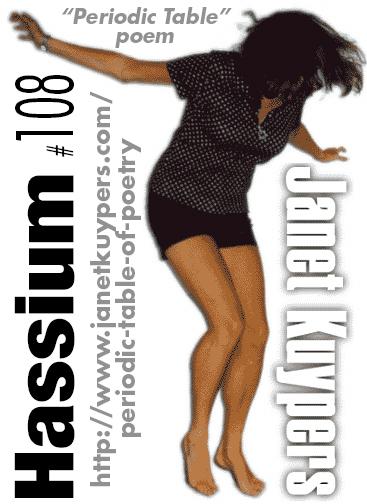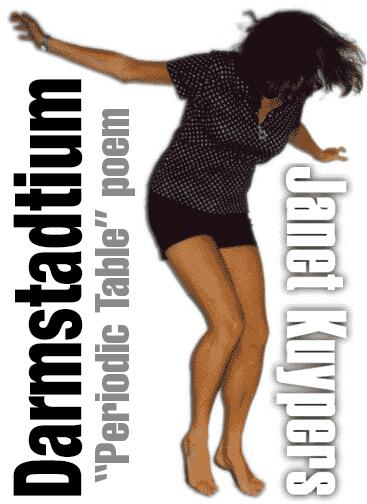Hassium
Janet Kuypers

from the “Periodic Table of Poetry” series (#108, Hs)
(8/22/14)
Hassium is a Periodic Table element
that was discovered in nineteen eighty-four.
Apple launched it’s first Macintosh
computer in nineteen eighty-four.
That’s also the same year
the first planet outside of our solar
system was discovered.
Nineteen eighty-four is the year
Nelson Mandela saw his wife
for the first time in twenty-two years.
It’s the same year Walter Payton
achieved the most rushing yards,
and the year Michael Jackson’s hair
was set on fire taping a Pepsi commercial.
It was the year McDonald’s sold
it’s fifty billionth hamburger.
Then again, it’s also the same year
vegetarian Fred Rogers (you know,
From Mr. Roger’s Neighborhood)
it was the same year he donated
his red sweater to the Smithsonian.
Although it had existed for decades,
nineteen eighty-four is the year
the AIDS virus was technically identified.
Don’t get Orwellian on me, but
it was a busy year, nineteen eighty-four.
Named for the German state of Hesse,
this radioactive synthetic element
(that’s an element that can be created
in a lab but is not found in nature)
seems to have a half life – the time
it takes for something to fall
to half its value because of radioactive
decay – it has a half life of only seconds…
But give the scientists some credit,
there have only been a little over
one hundred atoms of the transactinide
element Hassium synthesized to date.
I know that Russian scientists in Dubna
tried to synthesize this element in 1978,
but Darmstadt scientists in Germany
got it together in nineteen eighty-four.
“So… another radioactive synthetic
element, so what?” is probably
what you’re thinking right now,
and yeah, when it comes to it’s apparent
only value for scientific research
you’re probably right, but check out
this one cool sounding point
for element one oh eight…
According to calculations,
one oh eight is a proton magic number
(which means it is the number
of protons that will arrange into
complete shells in the atomic nucleus) —
and it’s the proton magic number
for deformed nuclei (that means
nuclei that are far from spherical).
This means the nucleus of Hassium 270
may be a deformed doubly magic nucleus.
Okay, it’s more science stuff,
but it’s cool to think
that an isotope of Hassium
can still have a perfectly arranged
nuclear shell in it’s atom,
while still remaining deformed
and look completely out of synch.
Makes sense for a radioactive
element that we created;
makes sense it’s a little off-base,
but still somehow together.
So I guess it’s kind of cool that
we were able to create an element
on the earth-shaking year
of nineteen eighty-four, and
that we’d make something so off-kilter,
but somehow still perfectly in balance,
considering everything it can
potentially do
if we ever made enough
to this radioactive stuff.

